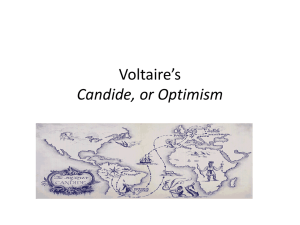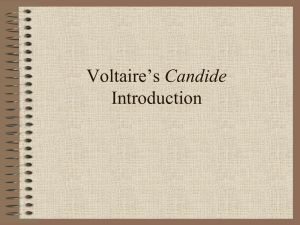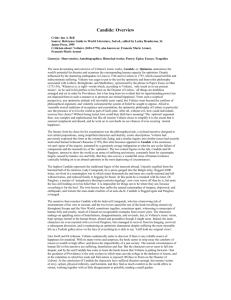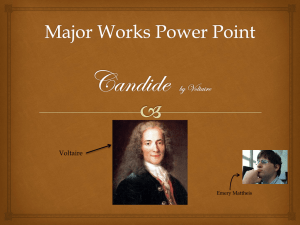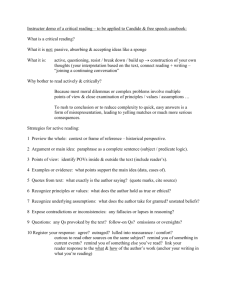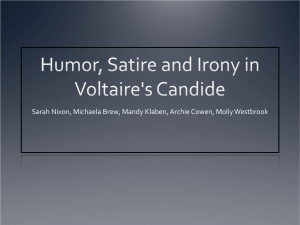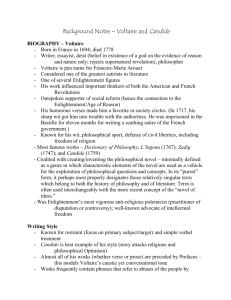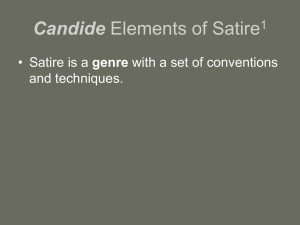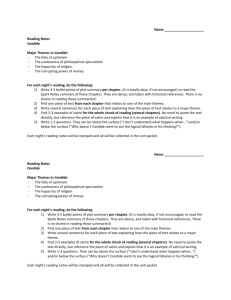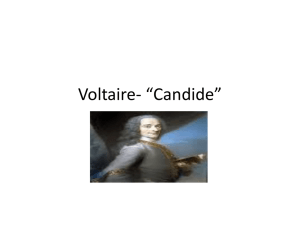A Candid Rendez-Vous with Reality in Voltaire`s Masterpiece
advertisement
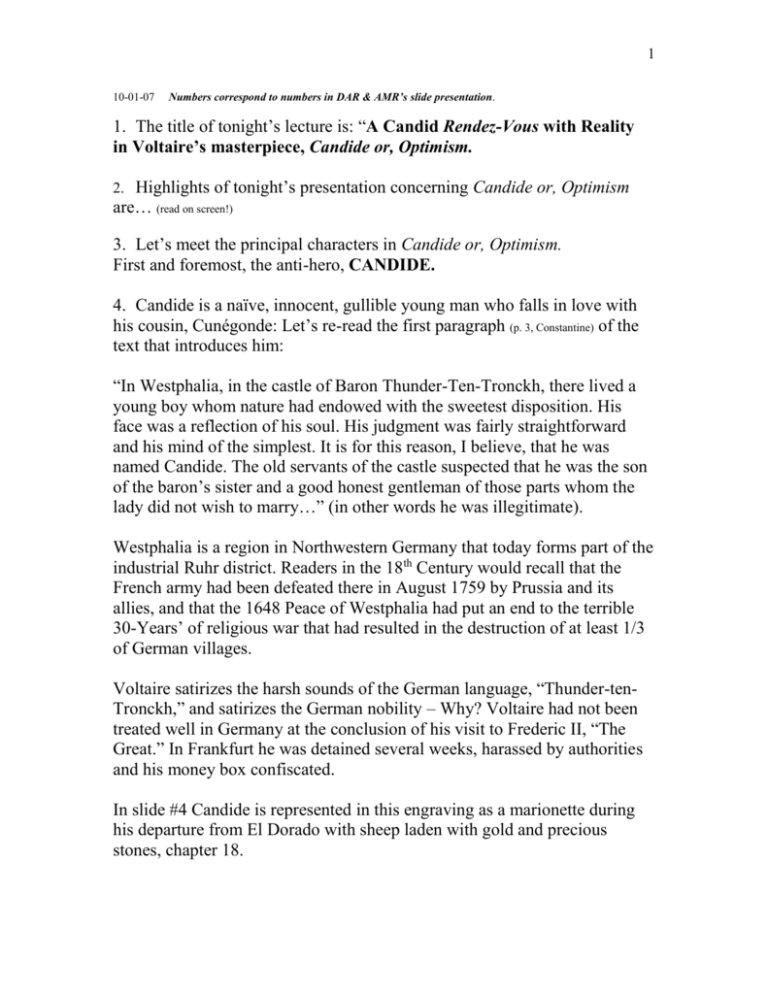
1 10-01-07 Numbers correspond to numbers in DAR & AMR’s slide presentation. 1. The title of tonight’s lecture is: “A Candid Rendez-Vous with Reality in Voltaire’s masterpiece, Candide or, Optimism. 2. Highlights of tonight’s presentation concerning Candide or, Optimism are… (read on screen!) 3. Let’s meet the principal characters in Candide or, Optimism. First and foremost, the anti-hero, CANDIDE. 4. Candide is a naïve, innocent, gullible young man who falls in love with his cousin, Cunégonde: Let’s re-read the first paragraph (p. 3, Constantine) of the text that introduces him: “In Westphalia, in the castle of Baron Thunder-Ten-Tronckh, there lived a young boy whom nature had endowed with the sweetest disposition. His face was a reflection of his soul. His judgment was fairly straightforward and his mind of the simplest. It is for this reason, I believe, that he was named Candide. The old servants of the castle suspected that he was the son of the baron’s sister and a good honest gentleman of those parts whom the lady did not wish to marry…” (in other words he was illegitimate). Westphalia is a region in Northwestern Germany that today forms part of the industrial Ruhr district. Readers in the 18th Century would recall that the French army had been defeated there in August 1759 by Prussia and its allies, and that the 1648 Peace of Westphalia had put an end to the terrible 30-Years’ of religious war that had resulted in the destruction of at least 1/3 of German villages. Voltaire satirizes the harsh sounds of the German language, “Thunder-tenTronckh,” and satirizes the German nobility – Why? Voltaire had not been treated well in Germany at the conclusion of his visit to Frederic II, “The Great.” In Frankfurt he was detained several weeks, harassed by authorities and his money box confiscated. In slide #4 Candide is represented in this engraving as a marionette during his departure from El Dorado with sheep laden with gold and precious stones, chapter 18. 2 5. CUNEGONDE is the daughter of the Baron de Thunder-ten-Tronckh, Candide’s cousin, and becomes his sweetheart, his raison d’être, his source of hope throughout the book as he tries to be reunited with Cunégonde. 6. She is 17 years of age, and has a “flushed complexion and was fresh, fat, and delectable,” fraîche, grasse, apétissante, in the original text. 7 & 8. (At the end of chapter one, Constantine p. 5 & 6, we read…): “One day Cunegonde was walking near the castle in a small wood that was called “the park,” when she saw Doctor Pangloss in the underbrush giving a lesson in experimental physics to her mother’s chambermaid, a pretty and obedient brunette. As Mademoiselle Cuneognde had a great aptitude for science, she watched with bated breath the repeated experiments to which she was witness. She perceived with great clarity the doctor’s sufficient reason, the effects and their causes, and returned to the castle quite excited, deep in thought, and filled with the desire to be learned, reflecting that she could well be young Candide’s sufficient reason…the following day…Cunegonde and Candide encountered each other behind a screen. Cunegonde dropped her handkerchief, Candide picked it up, she innocently took his hand, and the young man innocently kissed hers with exceptional vivacity, feeling, and grace. Their lips met, their eyes flashed, their knees trembled, and their hands strayed. Baron Thunder-Ten-Tronckh walked past the screen and, observing this cause and effect, chased Candide from the castle with hard kicks to his backside….” 9, 10. PANGLOSS is a philosopher: His name means “all tongue” in Greek. Pangloss is the mouthpiece for the ideas of two persons, German philosopher, metaphysician, theologian and mathematician Gottfried Wilhelm von Leibnitz, and also for French mathematician and physicistcosmologist, Pierre-Louis Maureau de Maupertuis. Pangloss is convinced that all is for the best in this world, a widely-held philosophical and metaphysical notion at the time called “optimism.” (Let’s revisit Pangloss’ statements, Constantine p. 4): “Pangloss taught meaphysico-theologo-cosmo-iditology. He could demonstrate quite admirably that there is no effect without a cause, and that in this best of all possible worlds, His Grace the Baron’s castle was the best 3 of all possible castles and Her Grace the best of all possible baronesses.” (with all her 350 pounds!) Anti-optimism, and anti-Leibnitzeanism is thus a predominant theme in Candide or, optimism. The title of the book is ironical; In Candide Voltaire attacks and thoroughly destroys the notion of a benevolent, providential deity whose perfection is supposedly reflected in this world and in the universe. Voltaire’s little novel, Candide, is a beautifully written, common sense approach to the philosophical, metaphysical “problem of evil,” or why bad things happen to humans. It is a rendez-vous, a confrontation with reality. The message of the book is that this world of ours is NOT “the best of all possible worlds.” In chapter one, Pangloss is Candide’s professor of philosophy at the baron’s castle, “Candide listened to Pangloss attentively and believed innocently,” Voltaire tells us. Candide has his doubts about Pangloss’ optimism from time to time in the novel, but only contradicts Pangloss at the very end of chapter 30 -- when Martin proposes to his companions Candide, Cunegonde, Brother Giroflée, Paquette, Cacambo, the Old Woman and Pangloss that they “work without reasoning” because it is “the only way to make life bearable.” Everyone in the little group agrees, except for Pangloss who repeats his a priori, specious reasoning -- from which he has never departed even once in the novel -- declaring that (p. 119, Constantine) “All events are linked in the best of all possible worlds. After all, had you not been chased from a fine castle with hard kicks to your backside for love of Mademoiselle Cunégonde, had you not been brought before the Inquisition, had not walked the length and breadth of the Americas on foot, not run your sword through the baron (Cungéonde’s brother), not lost all your sheep of the fine land of El Dorado, you would not be eating candied citrons and pistachios.” Candide’s polite response is: “That is well said…but we must cultivate our garden.” The real meaning of his words seems to be more forceful, something like, “Shut up and dig, get to work! Do something useful for once!” 11. Introducing CACAMBO: Candide’s faithful valet and companion is half Peruvian Indian and half European. Candide hires him in Cadiz, Spain, prior to departing for South America in chapter ten. Cacambo is a character in the literary tradition of the servant or lackey who is more experienced and more clever that his master: Sancho Panza in the Quijote is one example that comes to mind: Sancho the realist, Don Quijote, the idealist. 4 12. The two images refer to Candide and Cacambo’s exit from El Dorado. 13. Introducing MARTIN: A Manichean, a skeptic, and a pessimistic realist – and perhaps Voltaire’s own mouthpiece for his own temperament 17551760. Voltaire introduces his predecessor Pierre Bayle’s solution to the problem of evil: Manicheism. Manicheism refers to a dualistic religion in which Good and Evil are equally powerful, with roots in ancient Persia. Candide hires Martin in Surinam to have someone with whom he can philosophize during the voyage to Europe. Martin, a poor, Dutch scholar, has nothing to hope for: he had been robbed by his wife, beaten by his son, abandoned by his daughter and persecuted by preachers who considered him a Socinian or Antrinitarian. By the way, you may have read some recent newspaper editorials that have referred to George W. Bush as “Manichean,” in seeking to get across the idea that the president sees complex issues in overly simplified terms of either black or white. 15. Partial map of Candide’s travels. …(read lower portion of slide) Cunégonde and the Old Woman have additional itineraries reported in the novel. 16. A garden conjures up an image of peace and beauty, where all is well. There are three garden images in Candide or, Optimism. 17. Garden #1: The baron’s castle in Westphalia, a garden from which Candide is expelled in a parody of the Garden of Eden in the Book of Genesis in the Bible. (Read comment on slide). 18. Garden #2: The utopia of El Dorado. U-topia in Greek means “nowhere.” (Read comment on slide). 19. Garden #3: The farm near Constantinople (Istambul) … (Read comment on slide). 20. Candide’s journey: from naïveté to reality (read slide). Candide or, Optimism is an anti-war book. (Read from the beginning of ch.3, Constantine p. 9, a satirical, realistic picture of war). “Nothing was as beautiful, smart, dazzling, or well ordered as the two armies. The trumpets, fifes, oboes, drums, and cannons created a harmony such as never existed in Hell. First of all, the cannons struck down almost 5 six thousand men on each side. Then the muskets removed form the best of worlds between nine and ten thousand rogues infecting its surface. The bayonet was also the sufficient reason for the death of several thousand men. The total might well have come to some thirty thousand souls. Candide, trembling like a philosopher, hid himself as best he could during this heroic butchery. Finally, while the two kings had the Te Deum sung each in his camp, Candide decided to go elsewhere to reason over effects and causes. Climbing over heaps of dead and dying men, he arrived at a neighboring village that lay in ashes: it was the Avar village that the Bulgars had burnt down in accordance with the principles of international law. Old men covered in wounds watched their butchered wives die clasping their infants to their bleeding breasts. Girls who had been disemboweled after having sated the natural needs of some of the heroes were breathing their last. Others, covered in burns, were begging to be put out of their misery. Brains were splattered on the ground alongside severed arms and legs.” 21. Voltaire’s novel Candide is also anti-metaphysics. Leibnitz presented his theories of optimism in a book entitled Theodicy, a word he invented to refer the justification of the ways of God to mankind. Another celebrated proponent of optimism in the Eighteenth Century was the English author of the poem The Essay on Man, Alexander Pope, whose work was extremely popular among literate persons for over 100 years. The phrase “whatever is is right” from Pope’s Essay on Man is often quoted or remembered. More than 100 editions of three separate translations into French of the Essay on Man appeared prior to 1900 – a period in which knowledge of the French language internationally, especially on the Continent of Europe, was very widespread among those who were literate. 22. Maupertuis, mathematician and cosmologist, pictured here, had been Voltaire’s rival in love with Madame du Châtelet, a very intelligent woman who translated Newton’s Principia Matematica into French. In his recent book, Passionate Minds, David Bodanis reports all the many fascinating details of these relationships. Maupertuis extended his least action principle of mechanics in one giant, teleological leap to the perfection of creation and the existence of a Providential, Benevolent Deity. Voltaire makes fun of Maupertuis’s proof of God’s existence in the novel Candide, chapter 22. Maupertuis and the mathematician La Condamine, who happened to be 6 Voltaire’s friend, measured the meridian between earth’s poles: La Condamine south of the equator and Maupertuis to the north. It was Maupertuis who verified Newton’s calculations that the earth is flattened at the poles. On another occasion, La Condamine and Voltaire bought up all the discounted bonds in a state lottery, and both became very wealthy; Voltaire made additional shrewd investments and became one of the wealthiest individuals in Europe. Voltaire never had to worry about money again, a condition that made it possible for him to write and publish what he wanted, and ultimately to influence popular, public opinion as no one had before. In a recent book, The Best of All Possible Worlds: Mathematics and Destiny, mathematician Ivar Ekeland explains why Maupertuis’ least action principle and not just Leibnitz’s Theodicy was an object of Voltaire’s barbs against optimism in his little book, Candide. 23. The Enlightenment period, what was it and what has been its legacy? 24. Read screen: Details, Enlightenment. 25. What was it like to live in the Eighteenth Century as an aristocrat under the Old Regime? I recommend two excellent films: Ridicule, 1996, directed by Patrice Leconte, with a cast including Charles Behrling, Jean Rochefort, and Fanny Ardant and others. The Affair of the Necklace, 2001, based on a true story concerning Queen Marie-Antoinette, Jeanne de Valois, and the Cardinal de Rohan. This film was directed by Charles Shyer, and the actors included Hilary Swank, Johnathan Price, Joely Richardson, and others. 26. Themes in Candide or, Optimism: it is anti-war, and anti-metaphysics, anti-fanaticism, and anti-despotism. Tolerance is one of the main messages of the novel. 27. As Voltaire became older, especially after the Lisbon Earthquake, 1755, he became more concerned with the welfare of people and with blatant miscarriages of judicial procedure that arose from Catholic intolerance of Protestants. Every August 24, on the feast day of Saint Bartholomew, Voltaire became ill because he was horrified by the knowledge that on that day in 1572 some 3000 Protestants were massacred by Catholics in Paris. King Henry IV had promulgated the Edict of Nantes in 1685, an edict of religious tolerance to protect Protestants of the Reformed Church in France. Voltaire considered Henry IV a role model of tolerance and wrote a long epic poem to celebrate that king, La Henriade. 7 28. An auto-da-fe in pre-Earthquake Lisbon: Although the Inquisition no longer operated in France, the Inquisition was still very active in 18th Century Spain and Portugal, and in their colonies. In the novel Candide Pangloss is condemned to be burned as a heretic by the Inquisition in Lisbon; that Pangloss is saved by a rainstorm that extinguishes the fire and a poorly tied hangman’s noose does not diminish the horrible reality of the Holy Office of the Inquisition’s work in Lisbon and elsewhere: each year hundreds of individuals, mostly Jews, were accused of heresy, brought to trial and as many as 30 or more were convicted and handed over to the state for burning. 29. In the 18th Century the difference between England and France was like night and day: England had experienced a Civil War in the 17 th Century, and had a limited monarchy. France was still the country of one king, one law, one faith, and Louis XIV had revoked the Edict of Nantes, and Protestants were persecuted. Voltaire became involved in gaining a legal review and reversal by the King’s Council of several high profile cases in which Protestants had been wrongly executed. Voltaire’s influence on improvement in judicial procedures in France and elsewhere is today considered one of his most important accomplishments. 30. Other Enlighteners or philosophes: Jean-Jacques Rousseau; unlike Voltaire, he thought that civilization had corrupted man; Rousseau’s influence on political theory and educational theory has been very great, for better or worse! In the mid-18th Century Denis Diderot ensured the completion of the Encycolpedie, Dictionnaire Raisonne des Arts et des Metiers, 17 volumes of text that became an instrument of warfare against ignorance and prejudice as well as a means of spreading “new ideas.” 31. Thomas Jefferson: author of the Declaration of Independence, was influenced by the Enlighteners, John Locke, Jean-Jacques Rousseau, and others. 32. The legacy of the Enlightenment (read screen). Voltaire’s literary masterpiece Candide is the most accessible and enduring statement of the principles of the Enlightenment period that provided much of the intellectual background for the founding of our nation, and other moderate, modern democracies. 8 33. Voltaire certainly led one of the fullest, busiest and most interesting 84 years imaginable. 34, 35. Francois-Maire d’Arouet adopted the nom de plume “Voltaire” probably because he found that his family name was not very flattering. In any case, “Voltaire” is much more electrifying! 36. Voltaire loved Paris, but spent a good portion of his life, not by choice, living elsewhere. Fortunately he spent several years in England, learned English so well that he never forgot it, and experienced England’s relative freedom. When Voltaire returned to France he spread the liberal ideas of Locke and Newton in a 1734 publication: Letters Concerning the English Nation, or Lettres Philosophiques. Critic Gustave Lason called the lettres “the first bomb thrown against the Ancien Regime.” 37. Voltaire’s favorite hangout in London is still open for business! (Just joking). 38. A portrait of the Marquise du Chatelet, mentioned earlier. In addition to the book Passionate Minds by David Bodanis, I also recommend a recent, three-hour play about Voltaire and Emilie du Chatelet, Light, by Jean Claude Van Itallien. The play premiered in Pasadena at the Boston Court Theatre in fall 2004. 39. Voltaire at 65 (1759) when he published Candide or, Optimism. 40. A page from Chapter 24 of Voltaire’s original manuscript of Candide ou l’optimisme, next to a recent paperback edition printed in France. 41. The title of the book includes the word “optimism.” 42. A main thrust of the book is an attack on the obscure metaphysical doctrine of optimism or the goodness of the deity. 43. A timeline of 1750’s: Let’s focus now on a watershed, turning point event in Voltaire’s life and in the intellectual history of European philosophical and theological thought: the terrible 8.6 Earthquake, tsunami and fire that destroyed Lisbon, Portugal on All Saints’ Day, November 1, 1755, killing between 30,000 and 100,000 persons. According to the UC Berkeley Earthquake Engineering Research Center, the Lisbon Earthquake 9 would have registered 8.6 on the Richter scale. There was also earthquake destruction elsewhere in the Iberian Peninsula, and tsunami destruction and loss of life along the Atlantic coasts of Portugal and Morocco. The earthquake seems to have produced a crisis in Voltaire, and it appears in chapter 5 in the novel Candide. No one at the time knew that physical, natural forces caused earthquakes. The question on everyone’s mind at the time was: why would a benevolent God destroy Lisbon and so many human beings? For Voltaire the event clearly provided proof positive that this is not the best of all possible worlds. 44. At first there is a terrible storm at the end of chapter 4. 45. One of at least 100 engravings and paintings that may be viewed on UC Berkeley’s Earthquake Engineering Research Center’s website. 46. It is important for everyone to know and appreciate in some detail just what kind of city Lisbon had been prior to November 1, 1755. This is usually not mentioned in footnoted editions of Candide in French or in English. Prior to the 1755 earthquake Lisbon was a major European city equal to Rome, London and Paris. Portugal between 1700 and 1750 had regained much of its importance and prestige as a major European power. 47 (King John V). This was due to the huge influx of gold and diamonds imported into Portugal from its colony in Brazil. John V, who reigned from 1706-1750, made a serious and credible effort to emulate the flourishing of the arts in France, especially at Versailles, that had ocurred during the reign of Louis XIV who 1715. John V had the financial means to be a true patron of the arts. 48. The best artists, architects and musicians in Europe went to Lisbon during the first half of the 18th Century. Emmanuel Le Roy Ladurie, annaliste historian, in his preface to Brazilian Gold and Economic Growth in France in the 18th Century wrote that Portuguese purchases in France created a positive trade balance very much in France’s favor – resulting in enormous economic development, a doubling of French Gross Domenstic product (GDP) between 1715 and 1785. In the novel Eugenie Grandet Balzac’s miser gives to his daughter Eugenie each year on her birthday a handsome Portuguese gold coin bearing the likeness of John V, one reminder of Lisbon, Portugal in pre-Earthquake days. So an earthquake destroyed John V’s magnificent city of Lisbon. One wonders what would 10 have become of French culture had Versailles and Paris been destroyed instead. 49. The Marques de Pombal (read comments on slide). 50. Map of pre-Earthquake Lisbon. 51. Lisbon today: a major European capital of 2 million inhabitants in a small country of 10 million that has benefited enormously from 27 years o membership in the European Union. 52. Quiz time! I hope that everyone has read Candide or, Optimism. 53. Engraving #1: Candide takes advantage of the confusion of battle between the French and Germans to flee Germany to nearby Holland. 54. Engraving #2: The Old Woman has a surprise for Candide, and he is reunited with Cunegonde for a while in their travels from Lisbon to Buenos Aires. 55. Engraving #3. The Old Lady’s story of her many misfortunes: She began as an Italian princess who was kidnapped by pirates who fought over her. 56. Engraving #4. Candide thought he was saving two young women by shooting and killing two monkeys that had appeared to be attacking them; instead Cacambo informs Candide that he has killed the young ladies’ lovers. 57. Engraving #5. Voltaire’s comment on sugar plantation owners’ cruelties to black slaves in Dutch Surinam. 58. Engraving #6. Voltaire’s longest chapter in Candide is reserved for skewering the French capital’s inhabitants: unsophisticated intellectuals, religious bigots, frivolous gamblers, thieves and cheats of all sorts, and so on. No, Paris especially was not the best of all possible worlds. Questions???? Comments ???
